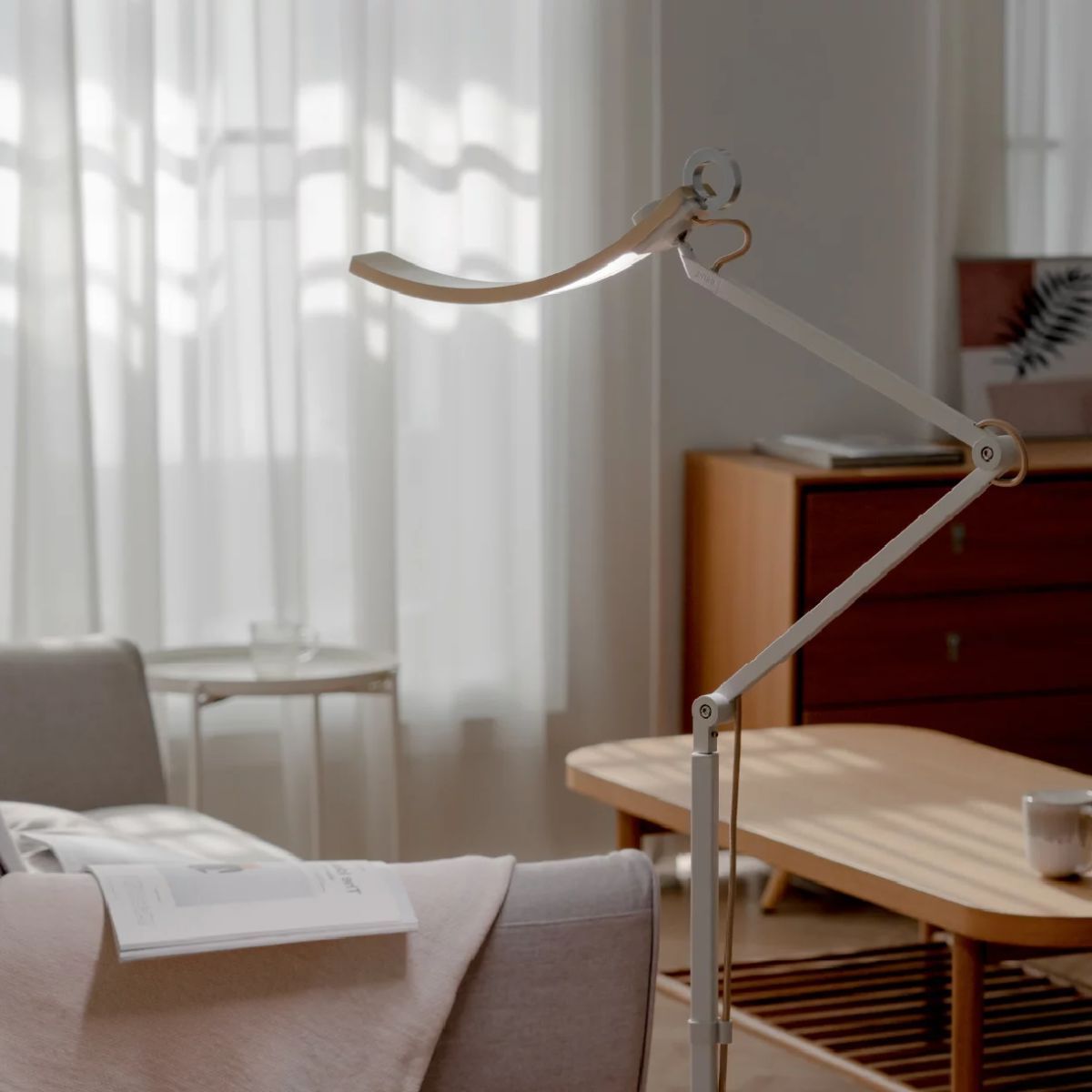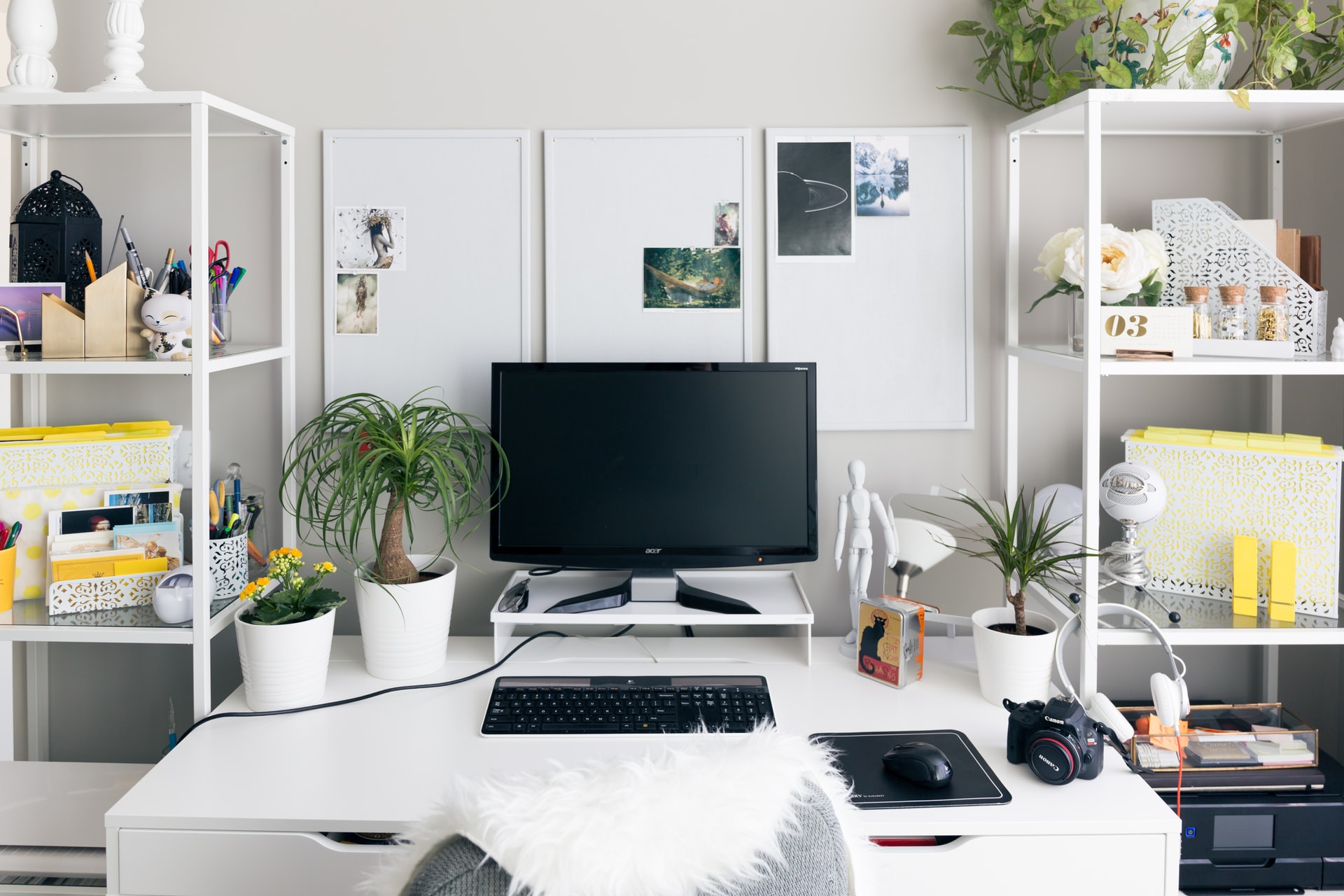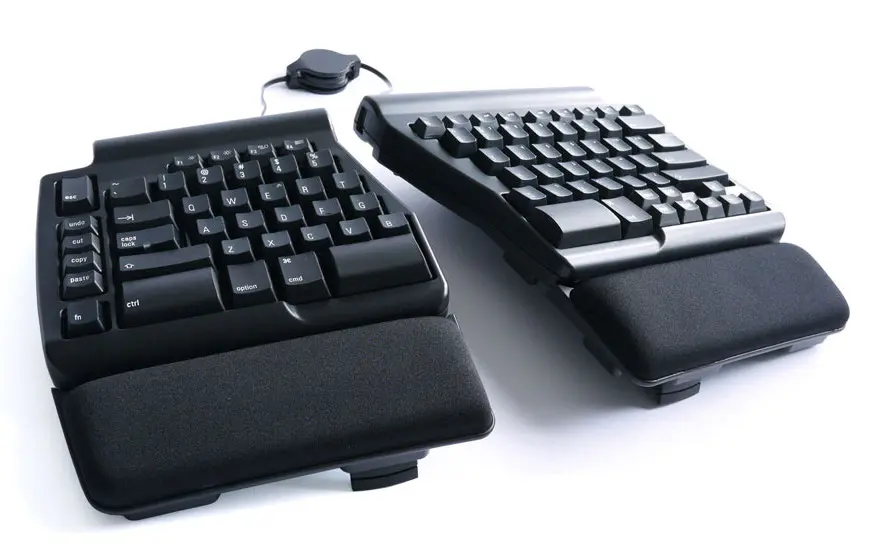The Best Air Purifiers For Your Home
Air Purifiers are amazing at soaking up toxins and tiny dust particles from any room in the house. This makes the air you breathe cleaner and safer. While you may not notice the daily benefits of it, your lungs will thank you in the long run. If you are like many people who have a desk in their bedroom and thus, spend most of their time in one room, air purifiers are highly important! Here are our top picks:
As an affiliate partner, I may earn qualifying purchases made on products.
1 AP-089 Air Purifier by Renpho
Top ProductThe Renpho AP-089 Air purifier is a very solid candidate which cracks our top three list. It has medical grade H13 filters (which rank higher than True HEPA) and can remove 99.97% of fine particles out of the air. This includes odor, dust, pet dander, and smoke. This air purifier can fully clean a room of 480 square feet within 30 minutes or less. Meaning, it will be even faster in a smaller room. At its price point, this air purifier stacks up very well compared to others that claim that much purifying capacity.
One knock on other purifiers is that some have bright lights that make it hard to sleep if they are positioned in the bedroom. This one is designed with that in mind, with a setting to turn off all display lights. It also features four speed settings, and an automatic mode which will cycle the speeds based on how many air particles it detects. Set it and forget it!
This comes comes with a lifetime support promise from Renpho, per their website. Available in white and black models.
2 Coway AP-1512HH Mighty Air Purifier with True HEPA and Eco Mode
Premium ChoiceThe Coway AP-1512HH has a four Stage Filtration System (Pre-filter, Deodorization filter, True HEPA filter, Vital Ion) which captures and reduces up to 99.97% of particles 0.3 microns in the air. It also reduces volatile organic compounds and reduces odor. It also has three fan speeds and a built in timer for when you want to automatically turn it off. At a 361 sq ft capacity, this purifier can handle just about any room in the house.
3 Blueair Blue Pure 411
Best ValueThe Blueair Blue Pure 411 is our great value pick. This is a solid purifier if you are on a budget and need it for a small to medium size room. At 175 square foot capacity, it can do the trick in most small bedrooms and offices. It also stays pretty quiet, reaching maximum decibel levels of 46, only when it’s turned on to maximum speeds to remove tough odor, dust, and other pollutants.
The Blue Air product lines are known for great energy ratings and are very quiet while turned on (which is 24/7 for most people). At normal periods it will sound like a whisper (31 decibels) and when it is tasked with cleaning a lot of dirty air, it will rise only to the sound of rain (56 decibels). And when it needs to clean a dirty room, it boasts a CADR score of 5, which means it could clean a room 5 times an hour if needed. That means your air will get purified quicker and faster for when toxins enter your environment. This is a premium choice and will cost you a pretty penny, but for people and families that value clean air (read our buyers guide on why you should), this machine is a great pick.
The Dyson TP01 deserves an honorable mention from us. It has a true HEPA filter that captures 99.7% of allergens and pollutants. Unfortunately, they do not document on their website what their filter’s maximum square feet capacity is, so take that with a grain of salt. We also just love the sleek design – it looks great in any sort of modern home. Plus, it doubles as a normal fan that will blow air and oscillate in any direction.
Coway’s Airmega 400 is a beast. At a room capacity of 1,560 square feet, it is best suited for large open floor plans. At its highest setting, it only gets up to 43.2 decibels which is quite low for such a powerful air purifier. It has a notification light for it’s washable filter and its Max2 HEPA filter for when it needs replacing. It has 5 air speeds and is energy efficient, so you won’t break the bank on your electricity bill. While this is obviously a huge machine, we highly recommend it if you value clean air and have a large open living space.
The Molekule Air Purifier is one of the most expensive air purifiers on the market today. It is beautiful and would look good in any room of the house. It has a leather strap attached, making it very portable as well. It’s incredibly strong and comes in at a 600 square foot capacity. Unfortunately, Molekule does not publish their CADR results so we cannot report on their rate and efficiency at which they clean the air.
If you really like the Molekule brand and design but the standard version is just too much, the Molekule Mini is far better priced and can still handle a 250 square foot capacity – great for most offices or bedrooms. As mentioned with the standard molekule size the mini version also does not publish their CADR results so we cannot report on their rate and efficiency at which they clean the air.
The Germ Guardian is best utilized in small rooms like a small office or bedroom. It is up to spec with industry standard HEPA ratings at removing 99.97% of harmful particles as small as .3 microns from the air. It’s CADR rating (check our buyer’s guide below for a full explanation of CADR) is Dust (118), Pollen (125), and Smoke (108).
The Winix 5500-2 Air Purifier has an excellent room capacity at 360 square feet CADR rating, making it one of the best value picks when looking at the max room capacity to price ratio. It also stays quiet at a 27.8 decibel level when on it’s resting speed. It’s smart sensor will also turn the fan higher/lower based on what levels of dust, odor, toxins, etc it picks up. This product ranks very similarly to the Coway AP-1512HH Mighty, although we like the Coway Mighty a bit more for its smaller size/weight, slightly larger capacity, and eco mode.
The Levoit Air Purifier has genuine replacement filters that are easy to replace. It has a Core 300 to fill your home office with crisp, clean air. It’s improved filtration system will lead to cleaner air for your home. Lastly, it is among the most quiet air cleaners. At a 215 sq ft capacity, it’s ideal for a moderately sized office or bedroom.
Buyer’s Guide: Buying The Best Air Purifiers
When looking at air purifiers there are a number of important things you should consider. Given that there are so many air purifiers on the market today, there is definitely one for everyone. We advise that you first figure out what you want to optimize for and make your buying decision based off of that. But to help guide you in that quest, here are the things we look for in air purifiers.
Room Size For Air Purifiers
How big of a room do you need to purify? This is a very important question to answer. Air purifiers are all measured by how big of a room they can filtrate, measured in square feet. In general, and for the purposes of this buyer’s guide, we can break down rooms into three sizes:
Small: 100 – 200 square feet (home offices and bedrooms)
Medium 200 – 350 square feet (living rooms, large bedrooms)
Large 350 – 500 square feet (open rooms that connect others like a living room/dining room combo)
There are a few things to remember about shopping for the right size air purifier. First, each product will display the maximum square footage they can filter air, at a 99.7% effective rate (more on that later). That measurement assumes an 8 foot ceiling; if you have high ceilings, you will want to do the math on what square foot capacity is right for you.
And second, if you have a room that is close to the limit of what an air purifier can cover, you should seriously consider a stronger purifier. This is because anytime the machine picks up on any toxins, dust, odor, etc it will have to work extra hard if it is near its square footage capacity. As a result, it will be loud and make noise for quite a long time. Conversely, a more powerful air purifier will be able to exert less energy, make less noise, and revert back to it’s normal sound level (which is basically undetectable to a normal ear).
In summary, buy a bigger purifier if you have high ceilings or if your room is close to the air purifier’s maximum capacity.
Best Air Purifiers And Price
There are three price points you should consider: the initial cost of the machine, the cost of the replacement filters (most require you to change it annually), and the energy cost (let’s just assume it will run 24/7). For the very diligent, looking into the electricity costs can sometimes be a swing vote for one versus another. So be mindful when looking at their energy efficiency ratings and let that guide you in your decision making.
More important than the energy costs however, are the replacement filter costs. Most purifiers suggest replacing filters each year. Some may even say up to eight months! Be sure to factor this in. Pro Tip: Air purifier companies also sell replacement filters to their products. Thus, it is in their best interest to encourage their customers to buy replacement filters as much as possible. We have read plenty of independent reviews and articles that document most air purifiers doing just as well with a one year old filter as a new one. So if you are looking to cut costs, consider replacing your filter every two years instead.
Clean Air Delivery Rate (CADR) and True HEPA Certification
There are a few important characteristics to look out for to ensure you’re making a worthwhile investment. First, you want to make sure that your air purifier has a high efficiency particulate air (HEPA) filter (see above). For air purifiers to be labeled HEPA, they must have been tested and individually certified by the U.S. Institute of Environmental Sciences and Technology or the International Organization for Standardization.
The Clean Air Delivery Rate basically measures how fast an air purifier can produce perfectly clean air. The higher the rate, the faster it will remove unwanted particles and toxins. For example, if a purifier can clean 100 cubic feet of air per minute while removing 90 percent of the air’s particles, it would get a 90 CADR.
High-efficiency particulate air, or HEPA refers to the amount of bad air particles that an air purifier filter will catch. HEPA air filter standards require at least 99.97% of air that passes through to be cleaned. But remember, if you buy an air purifier that claims it has a 99.97% HEPA efficiency rating up to 200 square feet, that rating will go way down if you choose to keep it in a room larger than 200 square feet. Generally speaking, if you see air purifiers that don’t have a True HEPA certification, you shouldn’t buy it.
Air Purifier Health Benefits
The quality of the air we breathe is more impactful on our health than most of us realize. On average, a person takes 20,000 breaths a day. That is 20,000 times each day that we may be exposing our bodies to potentially harmful pollutants that can wreak havoc on our heart and lungs, which we rely on to sustain our lives. And it is not only the outdoor air that matters – a World Health Organization fact sheet showed that 3.8 million premature deaths annually can be attributed to exposure to indoor air pollutants [source].
Exposure to air pollutants can lead to both short-term and long-term deleterious health effects. Temporarily, you can experience symptoms including irritation of your eyes, skin, throat, and nose,. Or you can experience dizziness, headaches, and nausea. Long-term effects include developing chronic illnesses that affect your heart and/or lunges. This includes lung cancer, COPD, and heart disease.
What Indoor Air Pollutants To Look Out For
There are certain toxins that are more robust depending on where you live. You may have higher pollutant concentration in your home if you live near a factory. Particularly, a factories that produce timber, dyes, metals, and chemicals can produce a lot of pollutants. These indoor pollutants include particulate matter (PM), greenhouse gases (i.e. ozone), nitrous oxide, etc. Other indoor pollutants can come from a variety of sources like smoking and cooking. Others include aerosols, burning incense sticks or candles, and allergens from fungi, dust mites, pollens, and pets.
An air pollutant is classified by its size, which characterizes where the pollutant deposits in human airways. Particles that are greater than 10 micrometers in diameter can mostly be filtered out through the nose and upper airways. Those particles that are smaller than 10 micrometer can enter and irritate our respiratory system. Particles less than 2.5 micrometers in diameter can travel all the way to the alveoli, the deepest part of our respiratory tract where gas exchange takes place. This is helpful to keep in mind when looking for an effective way to filter out air pollutants.
How To Avoid Buying A Scam Air Purifier
You may see Air Ionizers on the market as a more cost-effective solution. These try to market themselves as alternatives to HEPA air purifiers. However, not only are they ineffective, they are actually harmful for your health! The main component of Air Ionizers is ozone, the same greenhouse gas that composes smog. Ozone has been shown to have many adverse effects on our health. If you are currently using one, it is best to invest in an HEPA air purifier to begin to remove the ozone from the air [source].
Moreover, purifiers that use ultraviolet germicidal irradiation (UVGI), which shoot ultraviolet rays at nearby dangerous airborne organisms, may not be effective in eradicating large particles, odors, allergens, smoke, or chemicals [source]. Also, the UV bulbs must be replaced on a regular basis in order to be effective at eradicating any particles at all.
Lastly, electrostatic air purifiers have been very commonly used in office spaces and other industrial buildings to remove dust and airborne irritants yet have been shown to be significantly less effective than HEPA air purifiers. Electrostatic air purifiers use static electricity to trap airborne particles, which then get stuck on the sides of the air purifier’s filtration system. They are an appealing option because they require little maintenance but they also emit ozone, similar to Air Ionizers [source].
How Do I Maintain My HEPA Air Purifier So That It Continues to Work Effectively?
The specific maintenance guidelines for your HEPA air purifier will depend on the model and brand you purchase. You will want to investigate how frequently you will need to change out the HEPA filter and follow those instructions. Ordinarily, HEPA filters function optimally for between 6 months to 1 year. Some HEPA air purifiers have a filter indicator, which can help you easily detect when a filter needs to be changed. This is a useful feature to have so that you don’t unknowingly change out a filter before necessary.
HEPA air purifiers are always equipped with a pre-filter and a carbon filter. The pre-filter is the first filter that the air comes in contact with, and thus gets polluted quicker. Its function is to trap bigger particles before reaching the HEPA filter. Many pre-filters are washable so that you can remove them, wash them, and replace them on a monthly basis. The carbon filter lies between the pre-filter and the HEPA filter. The carbon filter’s main role is to remove odors from the air so you will be able to tell when it needs to be replaced if your air purifier begins to emit a foul odor.
When setting up your HEPA air purifier, make sure that the area immediately around the purifier is clean. Before cleaning your purifier, make sure you turn it off and unplug it. It is important to never use any types of solvents or detergents to clean your air purifier [source]. Although maintaining your HEPA air purifier can seem tedious, the burden is trivial when considering the health benefits it assures.
Other Ways To Purify The Air In Your Home
Because of the cost and upkeep that a quality HEPA air purifier entails, it may not be plausible to get an air purifier for every room in your home. Here are some simple and cost-effective ways that you can improve the purity and quality of the air indoors:
- In rooms where there is no air purifier present, keep a door and/or window open. If plausible, open doors or windows on opposite sides of the room so there is a constant draft that helps push toxins and allergens through the room rather than remaining stagnant.
- To reduce pet dander, brush your pet daily, use dander-reducing pet shampoo and conditioner when bathing them, and keep your pet’s hair short.
- Vacuum and clean all surfaces in your home where allergens and toxins can build up easily (i.e. carpets, couches, blankets) on a weekly basis.
- Minimize the use of candles, incense sticks, and open wood-burning fireplaces.
- Never smoke inside.
- Always turn on the exhaust fan in your kitchen when you’re cooking and leave it on for a couple minutes after you’re finished.
- Regularly check and replace the air filters in your heating, ventilation, and air conditioning systems in your home.
So Is An Air Purifier Right For Me?
If you value your health and well-being, the answer is an overwhelming yes! I personally swear by them. While I know anecdotal evidence is not scientific fact, I wanted to share my own experience with an air purifier. I have owned my Coway AP-1512HH Mighty Air Purifier for over two years now. I bought it mainly because I live in a high pollutant area that also gets a fair amount of smoke when wildfires occur. On smoky days (luckily there have only been a few), my Coway Might Air is able to clean my room within only a few minutes and once it is done, I can’t even hear it anymore. I also use a box fan to circulate fresh air as much as possible.
But even more importantly, I find myself no longer going to sleep or waking up with a stuffy nose. Smoke or no smoke, I was constantly having to blow my nose in the morning. Within literally one night of buying my air purifier and sleeping with it on, my nasal passageways had never felt better! And again, I realize this is anecdotal, but I have not gotten sick with any sort of cold like I’m usually prone to. It’s truly been a game changing product for my overall health and well-being. I couldn’t be more happy with it and I would recommend it to everyone!
Kevin is a WFH veteran. He has spent the better half of the past decade traveling the world while working remotely. Kevin has recently settled down and stopped traveling frequently, but continues to work from home and has created a spectacular home office. He loves reviewing new products for his office and sharing his insights so that people can improve their home office experience.




















